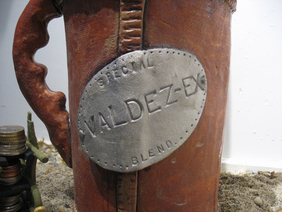Click on VALDEZ-EX Special Blend to go back to Once Gallery

This piece was shown at an Oakopolis Creativity Center exhibit entitled
Gratitude: Out of the Darkness
December - January 2008-09
Once Upon a Time…
…My father and I knelt with the deer, drank from the clean,
cold stream and I was grateful.
|
We were not strangers to nature. My parents came from farming stock. They knew where food came from and it wasn’t the grocery store. Their early family photos were like Dorothea Lange’s depression photos. Their clothing and unpainted homes matched the dirt that spread across the prairies around them, their hair imitating the dry winds.
After World War II everyone’s souls were uprooted and stored away, like precious antique seeds, to be saved for the next generation. Farming wasn't good enough for the veterans who were children of farmers. The sawmills flourished. One uncle lost his first finger in the mill and teased us mercilessly with its ghost. An aunt moved to Alaska where she grew cabbages the size of basketballs and made reindeer sausage. My father was the first person in my family to go to college. His degree in business and dreams of “his ship coming in” brought us to Berkeley. But his heart was still with homesteading and the land. So, even though I was born in Oakland with the melting pot of uprooted American farmers, we landed in suburbia and the first housing tract east of Berkeley’s coastal hills surrounded by oaks, walnut orchards and little family farms. We spent all our time-off in the Sierra Nevada mountain range. It took a long time to get there; an all day journey through farmlands and orchards with their hypnotic geometric flicker of rows and rows of white trunks and uniform gnarly branches that were sometimes naked and then swelling with buds, blossoms, leaves and bordering fruit stands. From grassland to oak to pine to timberline we bumped along on a one-lane road where we sometimes had to scrape past trees and boulders that were too large to remove. If we met another car coming downhill they had to back up until we could pass. I hiked and car-camped a lot in the Sierras from a young age. I marveled at the glistening white glaciers that covered the peaks all summer long. They were all about eternity. At the age of six I was the youngest person to sign the damp paper ledger at the summit of Mount Conness. The glacier that frosted the top and side of the peak hung at what seemed like a 60-degree angle. We had to cross its football field width in hiking boots with sticks for steadying our chopping steps. When we noticed lightning between my mother’s hands and the hair standing straight out from her head, we hastily put the rusty can holding the document of my accomplishment back under the granite rocks that poked up from the 12,649foot peak. In 1959, when I was at the magical age of nine, my father put an old wooden pack frame on my back and we “hit the trail” with my mother and 16 year old sister. I discovered the earth could sustain me as it is and I could survive in it with little more than a spoon, a cup, dried apples, beans, jerky and my family’s body warmth. And wow, it was hard work, but so worth it, not only because of the extraordinary beauty — we were experiencing our life source. And it was the only place where those hidden WW II seeds came out of storage and sprouted a bit. We didn’t want to know that within 40 years our little suburbia was going to divide and multiply until all the farms from Berkeley to the Sierras were gone to developing “paradise”. Today much of it is a concrete tombstone with the inscription: FORECLOSED. We didn’t want to know the sawmill towns and the forests would become ghost towns devoid of homosapiens and Coho salmon. When was the last time you drove up through northern California and Oregon toward Alaska and stopped to stretch your legs in the forest alongside the road? It’s like a wild-west-false-front-set from Hollywood. The “forest” is only a few trees deep, beyond them it’s clear-cut. In 1995 I was arrested to protect the last stand of old growth redwoods in California. - continued next column - |
In 1998, when I hit the magical age of 48, my cousin, Jan, took me on a trip to Alaska. I got to visit my aunt (the one with the giant cabbages), uncle and grown boy cousins, in their log cabin in Chugiak. It was all a first. We flew in a single engine prop plane around the 20,320-foot peak of Denali (Mount McKinley) and its surrounding glaciers. I was stunned by how much the snaking glacier flow looked like a freeway. As it moves, melts and grows it creates Ogives — ridges and valleys of dark & light, representing the seasonal motion and increased velocity toward the glacier’s center-line, creating the effect of freeway striping.
We went on a bus tour to Kenai Fjords National Park, mantled by the 300-square-mile Harding ice field. We were going to visit one of its massive fingers, the Exit Glacier. We drove and drove on a winding, 9-mile long, half gravel road to the Ranger Station and visitor center, built specifically for viewing this natural wonder. When we arrived we stood outside watching an iceberg float by on an outwash plain, as we were informed the glacier was no longer visible because it had receded back into its fjord due to global warming. They waited to tell us until we arrived, to make a point. When we returned to my aunt’s, she snorted, “It’s worse than that. Look at this!” She bustled into the other room and returned with a photo. “These are your cousins standing at the foot of that glacier in about 1968, where you started out on that winding 9-mile road.” I got to go kayaking in Prince William Sound in 1998. Taking off from the tiny town of Cordova, I skimmed along at water level with yellow and orange jellies floating along side me. Occasionally one would give me a wink, fold itself, duck under my kayak and pop up on the other side. It all looked pristinely clean and clear. We reached a small island and sat by sea stars that had been washed ashore in the last storm that ended with a pulsating, green, northern light display. Sitting on the beach, we dug down through the sand and gravel about 6 inches to find gobs of thick, sticky, icky, black oil still there from the Exxon Valdez oil spill 9 years earlier. (I heard a woman from Alaska on the radio, a week before this 2008 exhibit opened, talking about taking students out to the 1200 miles of coastline in Prince William Sound to show them that the oil is still there, now 6-12inches down in the sand and gravel. The spill was the largest in North America. Exxon has just now agreed to pay drastically lowered punitive damages after almost 20 years. Animal populations have yet to return to previous levels. A few months after Alaska, back home in Oaktown, I was creeping along in traffic on our very own Highway 13. After about 15 minutes of inching my car forward, I arrived at the electric sign that read, “WARNING, SLOW TRAFFIC AHEAD”. Then I saw it as a sculpture…all of the cars bumper-to-bumper, side by side, snaking along between the hills and the false-front-forests, driving right up onto the glaciers, melting and mining them for oil. You say this is old news? It’s our future. And yes, all is connected. We can’t drink the water from the streams any longer. How many “cups and spoons” do we really need to live a healthy, comfortable, modern life? And how can we make, deliver and consume them without draining our life source? It’s time for some big changes. And all of us creative thinkers: artists, scientists, inventors, healers, parents, teachers, garbage collectors… can move…“Out of the Darkness”. © 2009 Vicki Gunter |
